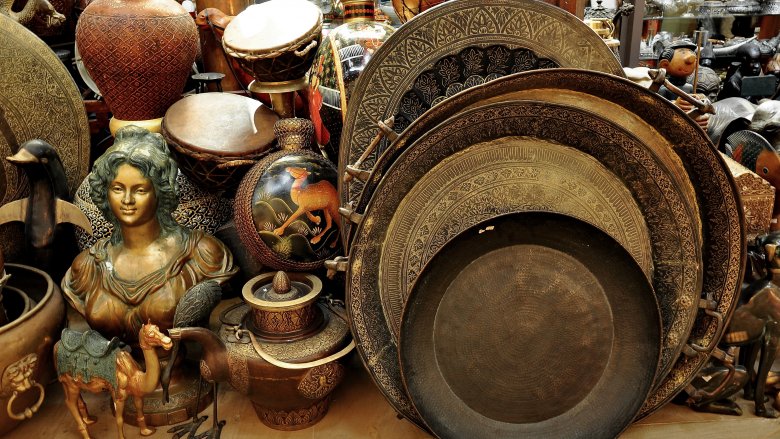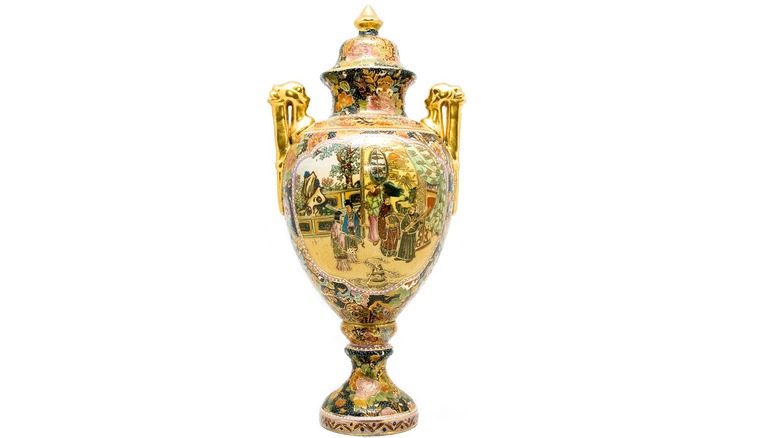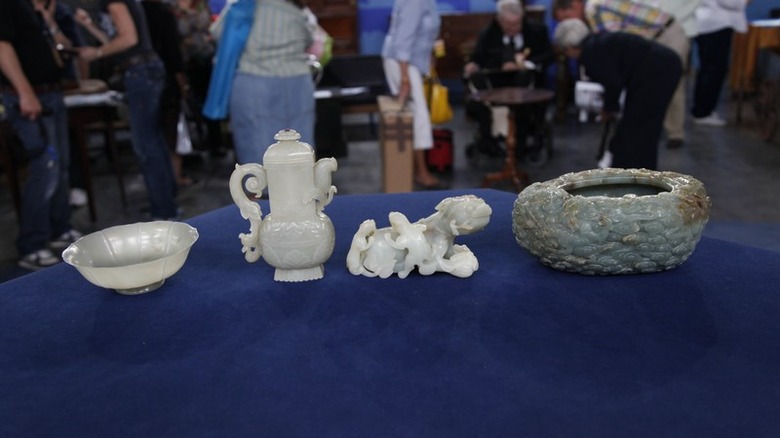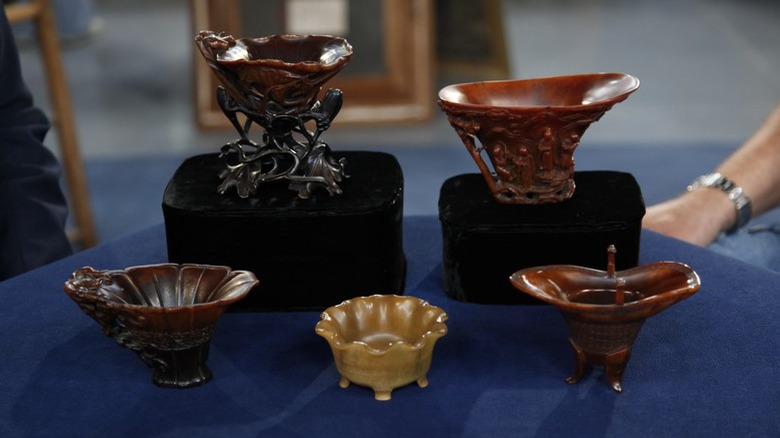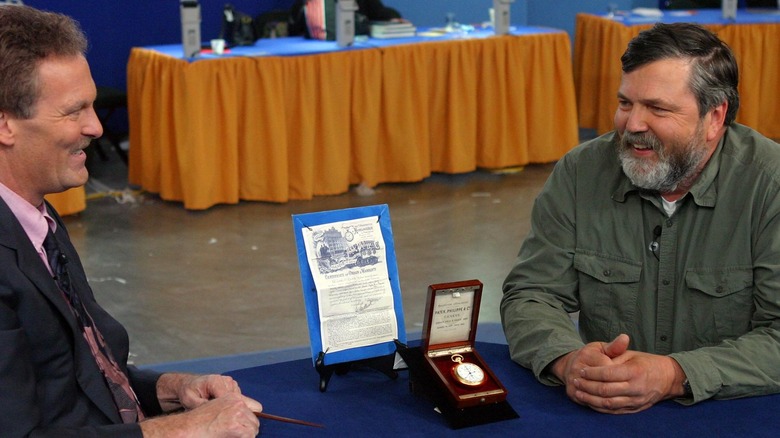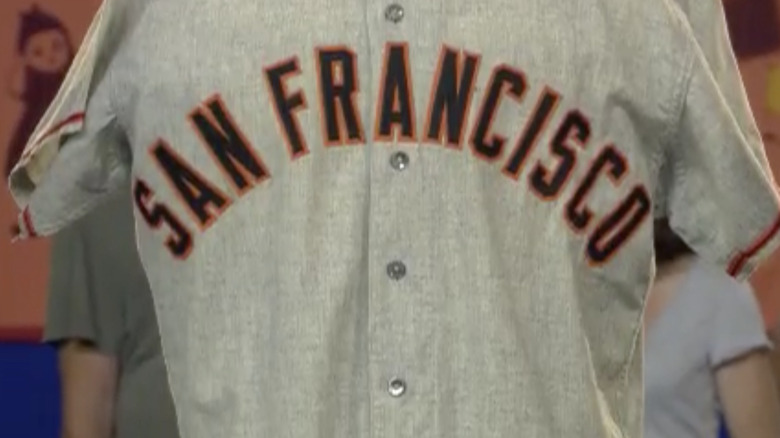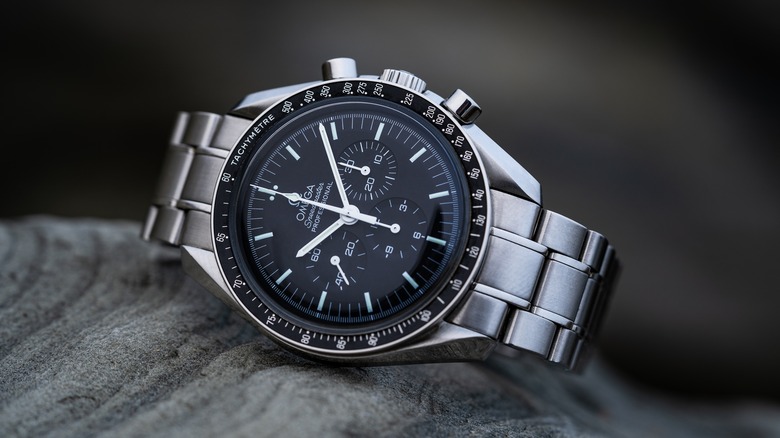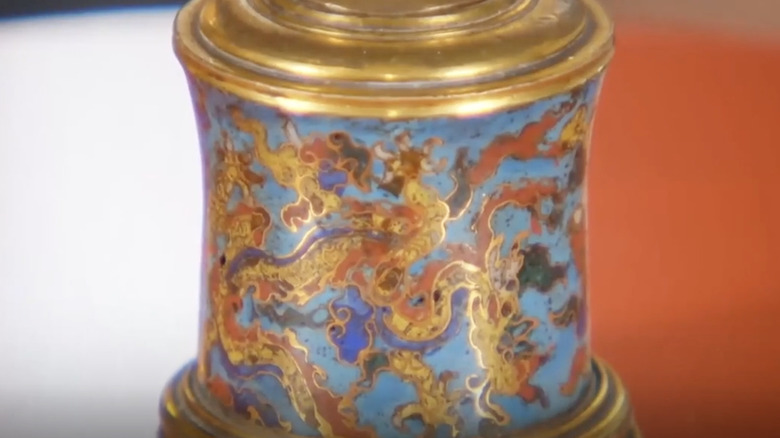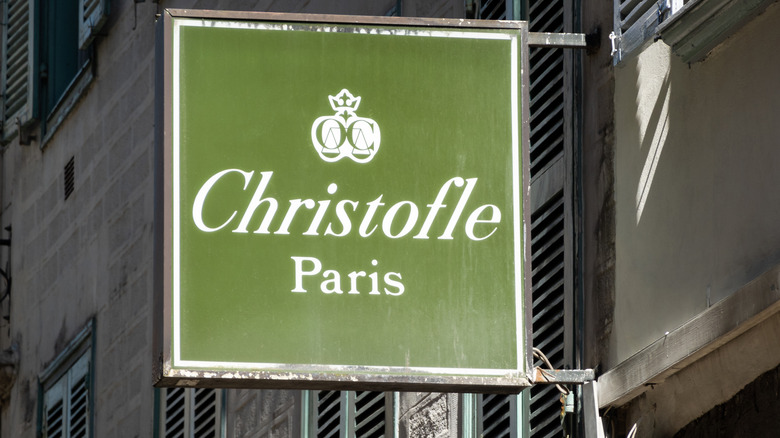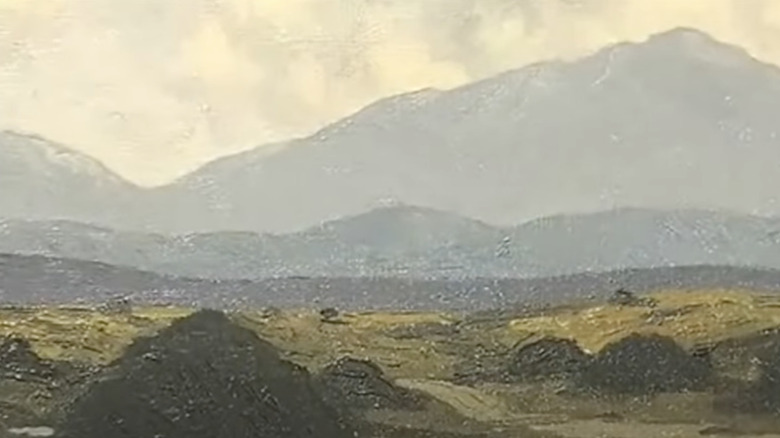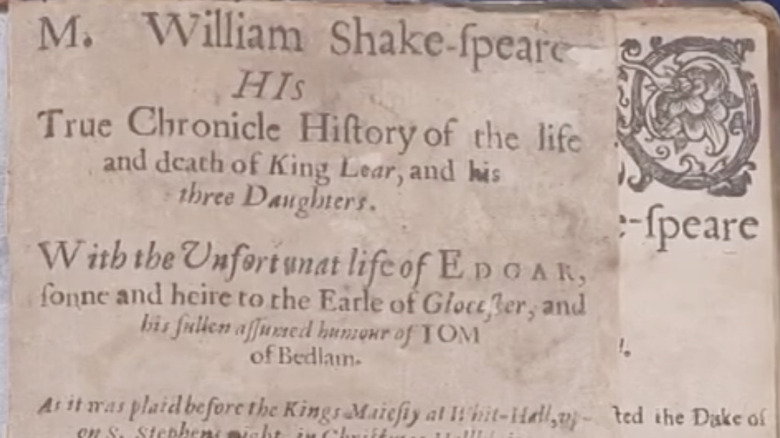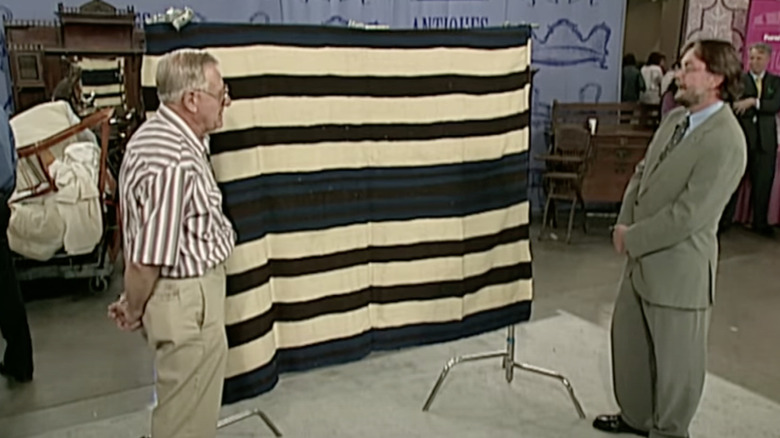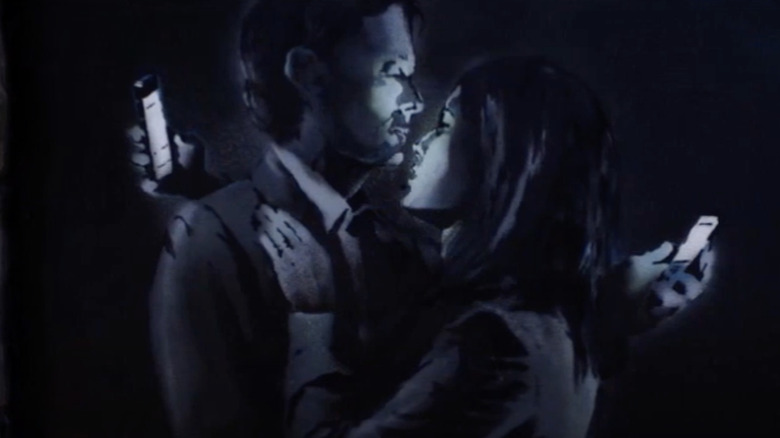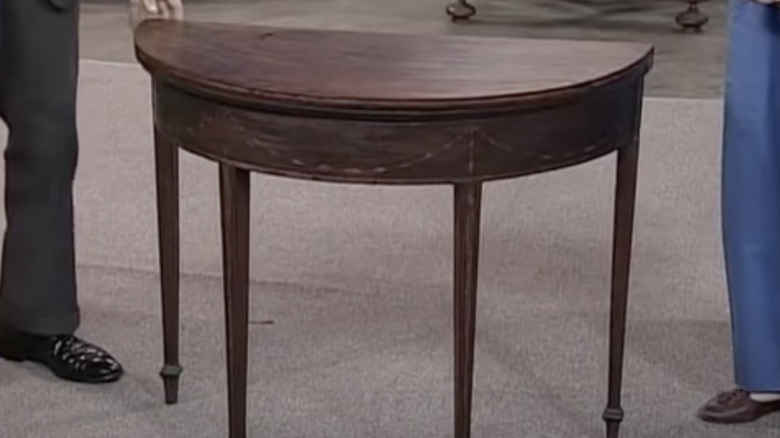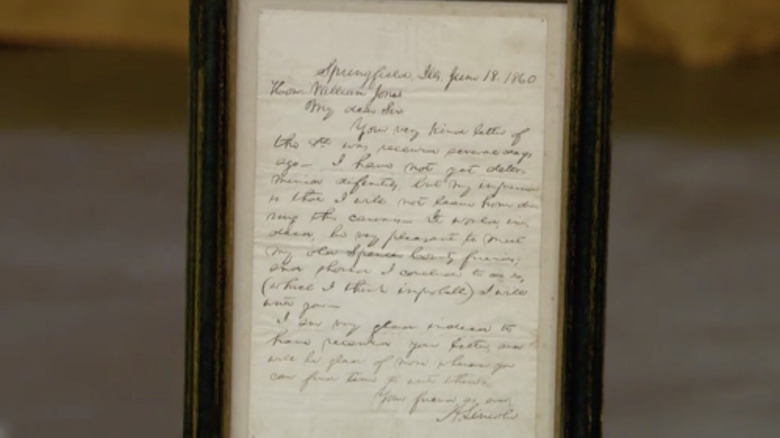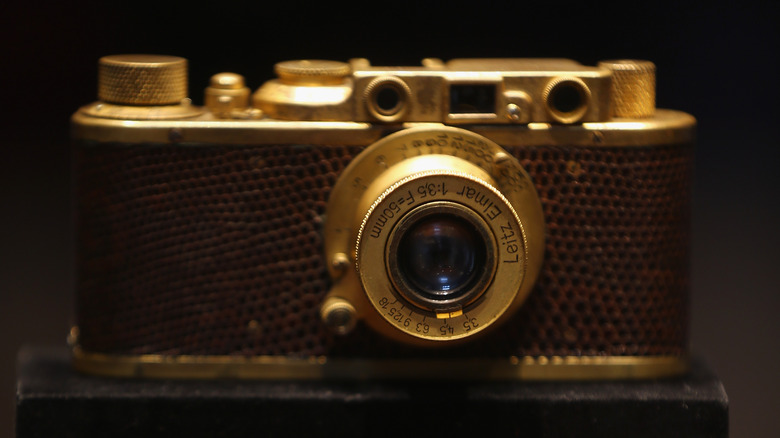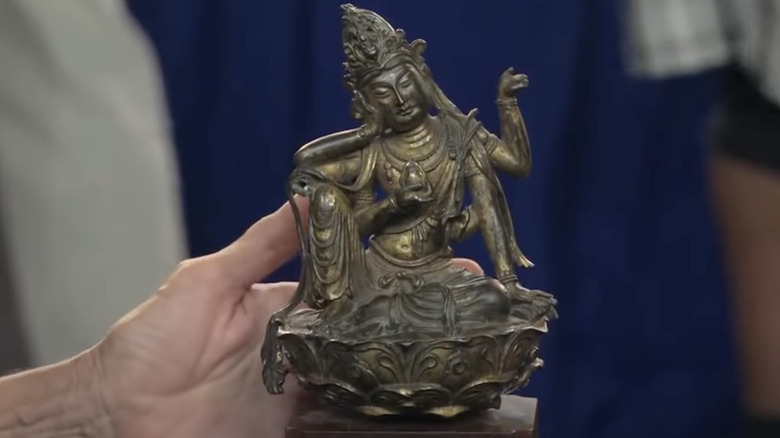Antiques Roadshow Items That Made The Owners Crazy Rich
"Antiques Roadshow" debuted on the BBC in 1977 as a documentary series about an auction house before turning to the more familiar format (in which appraisers travel around looking at antiques brought in by locals) in 1979. It's run ever since. The United States version of the show debuted on PBS in 1997 and hasn't looked back.
If you've seen the show, you know that it's primarily older people bringing dusty junk from their attic hoping to make a million dollars. Usually they get told to take their dusty junk back home and be glad they got to be on television, even if it was just PBS. Sometimes, however, these folks have dusty junk that is actually worth a million dollars. Or, you know, a million pounds if it's the U.K. version.
What follows is a list of some of the most highly appraised items in the history of the show, from both the U.S. and the United Kingdom. In some cases, the owners liquidated the items and made themselves cash-rich, while others held onto the items to shrewdly let them appreciate in value or to (yawn) bask in their sentimental value until parting ways — and making some serious coin. These are definitely enough to make you go dig through your own attic.
£600,000 urn
On a 1991 episode of the U.K. "Roadshow," a man brought in a flower pot that had been in his family for years, primarily used by the children of the family as a goalpost in their soccer games. Once on the show, expert Eric Knowles revealed that the flower pot was not actually a flower pot, but was instead a jardiniere, which a quick Google search reveals a French word that means "flower pot." Furthermore, the urn was an 1874 piece done in the "Japonisme" style, which a quick Google search reveals is a French word for white Europeans biting the style of then-new Japanese art imports. This 19th-century weeaboo pot was valued at £10,000, which one hopefully final quick Google search reveals is about $13,000.
Despite the urn (not literally the one pictured above) being appraised at a value 100 times as great as the £100 the man's father bought it for in 1946, the main decided to hold on to it for another 23 years, which turned out to be a super smart move. In the time since the episode aired, the ceramic monument to cultural appropriation had appreciated in value a considerable amount, and in 2014, the man sold his former makeshift soccer goal for a staggering £668,000 (£560,000 after commission, according to the BBC), which one actually final quick Google search reveals is $880,000 and $738,000 respectively, neither anything to sneeze at.
$1 million jade collection
All right, here we go, time for some jokes about an 18th-century jade collection. Yep, let's dig into the fertile joke soil that is antique jade. Well, according to The Washington Post, this collection was bought by the owner's father in the 1930s on Beijing's Jade Street, which seems like a good place to buy jade, similar to how Americans buy their most valuable groceries on Grocery Street. Okay, all right. One-third of the way there. Just power through. Jade jokes.
This collection included four pieces from the 18th-century reign of Qianlong, including a bowl with a dragon on it that once got stolen and then sold and then held hostage for $5,000, which is probably the wildest thing you'll read about a bowl today, except for that fan theory about how Chip from "Beauty and the Beast" was born.
At any rate, it turned out that paying that five grand was worth it, because Asian art expert James Callahan appraised the collection at the shockingly specific range of $710,000 to $1,070,000 at auction, which at the time of the episode in 2009 was the record-high appraisal for the show. And that was only a very small part of the whole jade collection accumulated over the years. You could say, then, that the owners of this collection had it made in the jade. (Nailed it.) The owner sold the collection shortly thereafter — although it didn't quite fetch the appraisal price, the owner still pocketed a sweet $494,615.
In conclusion, 18th-century China was a land of contrasts.
$1.5 million rhino horn cups
Let's be super clear about one thing just right up top: absolutely do not under any circumstances buy anything made from rhino horns ever for any reason. Rhinos are hella endangered, and the chief reason is people hunting them for their horns. Rhino horns: not even once.
That said, this guy in Tulsa definitely made a million and a half dollars on some rhino horn cups back in 2011. He started collecting things made from rhinoceros horn back in the '70s, when it was still socially acceptable to do things like step on bald eagle eggs and put cigarettes out on babies, so maybe depleting the population of Earth's most majestic pointy wrinkle boys wasn't seen as such a big deal. Over the years, he continued picking up similar pieces until he had a full set, spending a total of about $5,000 for the five pieces. It turns out they were all ceremonial libation cups made in 17th- and 18th-century China, according to Lark E. Mason, the show's Asian art expert. Mason then went on to shock the cups' owner by valuing the set at between $1 million and $1.5 million, the highest valuation on any item in the show's history at the time. PBS later gave an update in an article outlining the ethics of items derived from endangered animals that the owner had successfully sold two of his five cups at auction for over $300,000 in 2015.
$1.5 million pocket watch
It turns out that in the days before you could just look at your pocket supercomputer or yell "ALEXA WHAT TIME IS IT" at your dedicated House Robot, watches were a pretty common thing for people to have, and not just as sponsors for their podcast. They were kind of like Fitbits except without the part that tells you how many steps you took or how fast your heart is beating. It, well, it was actually just the "what time is it" part, mostly.
The Swiss were and are particularly good at making watches, and the Swiss company Patek Philippe is apparently super renowned for it, according to Paul Hartquist, the guy on "Antiques Roadshow" whose job is to be good at watches. In 2004, when a man came on the show with a Patek Philippe watch handed down to him from his great-grandfather that had cool features like a calendar that accounted for leap years and a moon-phase indicator, Hartquist basically lost his mind, but in the way you'd expect a person to lose his mind on PBS: very calmly intoning that it was the finest watch he had ever seen. He subsequently valued the watch at $250,000. But it turns out he wasn't accounting for the fact that this watch was a custom job, and in 2016, the watch brought $1.5 million at auction, a full six times the valuation amount. Hartquist is either bad at watches or bad at auction predictions.
$31,000 baseball jersey
"Antiques Roadshow" rolled into Atlanta to tape episodes to air in 2012, and a viewer brought in for appraisal a vintage piece of sports memorabilia. His late uncle collected sports stuff, and after he loved looking at it over 30 years of visits with his aunt, he came into possession of the cherished item: a Willie Mays uniform. Bearing the name of the baseball legend stitched into the shirt as well as the year "61," the uniform is a San Francisco Giants away jersey, made of flannel wool and with pants fully intact (with Mays' name and size imprinted in the waistband). Appraiser Mike Gutierrez estimated that on a grading scale of 1 to 10, the uniform could land a 9 or a 10 and sell at auction for anywhere between $25,000 to $35,000.
Guiterrez's appraisal would prove to be spot on. Declining to sell the item through the auction process, the uniform's owner, identifying himself only as John, took his prized possession to Gold & Silver Pawn Shop, the establishment featured on another treasures-based reality TV show, "Pawn Stars." Proprietor Corey Harrison, in front of his program's TV cameras, paid John $31,000 for the Willie Mays uniform.
£31,000 watch
U.K. citizen Roger Cooper was a member of the Merchant Navy, and while in Hong Kong in 1968 he bought a nice wristwatch, an Omega Speedmaster model. A 21st birthday present to himself, Cooper plunked down £35 to a wholesaler for the timepiece, a hefty sum considering his weekly salary at the time was £10. After appearing prominently on the internationally popular Japanese action TV show "Ultraman" in 1971, the watch picked up that series' name as a nickname.
Cooper wore his Ultraman watch daily for more than a decade, retiring it from use in 1983 because he was tired of it getting scratched and beaten up during his labors as a sailor. In 2018, he thought his old watch might be worth something and wrote a letter to the British version of "Antiques Roadshow" to ask about an appraisal. Producers contacted Cooper and had him appear with his watch on an episode taping that aired in 2019. It's there that appraiser and expert Richard Price told Cooper that his watch was worth between £30,000 and £40,000. And that's roughly the sizable fortune Price received when he sold the watch through Gardiner Houlgate's auction services. The 51-year-old watch, of which only 50 were made, netted Cooper £31,000.
£50,000 water dropper
In 1989, a resident of Newcastle, U.K., attended an antiques fair in the coastal village of Tynemouth and spent £10 on what looked like a teacup or tea accessory. "I hadn't a clue what it was, I just liked the colors," the woman said when she brought the item, laden with bronze touches and dragons rendered in enamel, to an episode taping of "Antiques Roadshow" broadcast by the BBC in 2019, according to ChronicleLive. Show appraiser Lee Young explained that the object was in fact a water dropper, used by a scribe to insert small amounts of water into calligraphy ink as they worked. Additionally, by Young's assessment, the water dropper was approximately dated to the Ming Dynasty era of Chinese history around 1600, and was worth in the neighborhood of £10,000 to £15,000.
Weeks after the episode aired, the owner took her centuries-old Chinese water dropper to Thomas N. Miller, an auction house in Newcastle. With online bidding and lines open directly to Chinese buyers, the antique sold for £50,000.
£668,000 vase
In 1946, Terry Nurrish's mother bought an art item at an antiques show. She spent £100 on the blue-green vase adorned with images of birds, clouds, and flowers, and ornamented with numerous gold flourishes atop a similarly intricate and gilded golden stand. Altogether, it stands 5 feet tall. "I liked it so much, and so did my wife, so my mum gifted it to us when we got married in 1984," Nurrish told The Sun. For years, Nurrish moved the item around different rooms of his farmhouse near Grimsby, U.K., and at one point, his children employed it as a makeshift soccer goalpost.
In 1992, an art enthusiast friend suggested Nurrish get it appraised on "Antiques Roadshow," and he did. Appraiser Eric Knowles guessed that the piece could fetch £10,000, as it was a rare and important piece of art. It was built by the French goldsmith Christofle for the 1874 Paris Exhibition, and at some point, the enamel, bronze, and gilt work had made its way to England.
Nurrish didn't sell the artwork right away, waiting 20 years when he realized he couldn't bequeath it to just one of his children without the others getting upset. Its value had increased significantly since the "Antiques Roadshow" appraisal — the Christofle work sold at auction for £668,000. Nurrish used the money to buy a BMW, build homes for his children, and take a two-week vacation to Asia.
£52,700 painting
One of the most significant painters to emerge from what is now Northern Ireland, Paul Henry was born in Belfast in 1876, studied art in Paris, and then settled in Dublin, where he died in the 1950s. In 1938, private school founder William Toone purchased "The Bog Road," a depiction of the Irish countryside, straight from Henry, and the piece stayed in the Toone family thereafter, eventually winding up in the hands of grandson David Toone.
Not knowing outright that the out-of-circulation piece by a major Irish artist was worth a fortune, David's wife hauled "The Bog Road" to an "Antiques Roadshow" event in the U.K. in 2010. Expert art appraiser Rupert Maas estimated that "The Bog Road" could be valued at around £39,500. But when the Toones decided to sell the piece through Adam's Auctioneers in Dublin, Ireland, it commanded a much higher figure. A buyer, who kept their name out of media reports, paid £52,700 for the landscape painting.
$46,000 copy of King Lear
The American version of "Antiques Roadshow" set up a taping in Shelburne, Vermont, in 2022. Late in the event, a man identified only as Mike headed for the rare and antique books station to receive an appraisal from expert Devon Eastlund. Mike's grandfather had bequeathed to him his book collection, and he was unaware that among those effects was a copy of "King Lear," one of playwright William Shakespeare's most famous and enduring tragedies. First written and performed in the early 1600s, Mike's copy of the script was produced by London printer Jane Bell in 1655. On account of how this "King Lear" came in the smaller, quarto format (versus the much more prominent large-format folio editions) and was made by one of the few female-fronted presses of 1600s Europe, Eastlund estimated that Mike's century's old book was worth at least $10,000 to $15,000.
Eastlund arranged for the sale of this "King Lear" copy via her employer, Swann Galleries. On auction day in October 2022, Mike's book fetched $46,000.
$500,000 Navajo blanket
Back in 2002, PBS' "Antiques Roadshow" aired one of the biggest appraisals in its history, taped at a 2001 stop in Tucson, Arizona. Ted Kuntz brought in a striped blanket he believed to be of Navajo origin. A collector of Native American artifacts since the 1950s, he'd thrown the blanket over a chair in his home after using it as a bedspread as a child in the home of his grandmother, who reportedly received it as a gift from a relative who claimed to have acquired it from Old West icon Kit Carson.
Kuntz's information was correct but incomplete. Visibly elated "Antiques Roadshow" appraiser Donald Ellis informed Kuntz that the blanket was handwoven specifically for a Ute chief in the Navajo community. Not only rare, it was old, too, produced between 1840 and 1860. Ellis said that at worst, the blanket could fetch $350,000 at auction, and at best, up to $500,000.
With all that in mind, Kuntz sold the blanket to an anonymous party who vowed to bring the item to a place where it could be properly cared for and shared with the world. The Ute chief blanket was donated to the Detroit Institute of Arts Museum. Kuntz didn't disclose how much he personally made from the sale of the blanket, but it was enough to buy a home, provide financial assistance to relatives, and a nest egg for himself and his wife to fund their retirement and medical expenses.
£403,000 Banksy mural
"Banksy" is the name of a secretive and anonymous individual or collective devoted to creating visual art in public spaces generally without permission or warning. It's usually politically charged or offers social commentary in some manner, and any time Banksy strikes it makes headlines in the U.K. In April 2014, for example, Banksy took credit for "Mobile Lovers," a mural-style portrait of two young people embracing but entranced by their glowing smartphone screens between one another's backs, that appeared on a door-covering piece of wood at the Broad Plain Boys' Club in Bristol, U.K.
The nonprofit organization aids underprivileged children in Bristol (purportedly Banksy's town of birth), and seeing as how "Mobile Lovers" was confined to an easily portable plank of wood, Broad Plain Boys' Club leaders took in the work to a May 2014 "Antiques Roadshow" taping for appraisal. Art experts at the show, valuing its uniqueness and status as a Banksy original, determined that "Mobile Lovers" could pull in £400,000 if sold. After being showcased at the Bristol Museum and Art Gallery for a few months, an anonymous purchaser bought "Mobile Lovers" for a little bit more than its estimated value. That £403,000 helped keep the Broad Plain Boys' Club open and able to serve the community.
$490,000 card table
In the late 1960s, Claire Wiegand-Beckmann had just moved into a new house in Bergen County, New Jersey, and hunted the area for necessary furnishings. She needed a small table and found one at a yard sale. The owner wanted $30 for the table, painted black and covered in mold, and Wiegand-Beckmann talked her down to $25. About 30 years later, at a Secaucus, New Jersey, taping of "Antiques Roadshow," Wiegand-Beckmann brought in the since-restored small, half-moon-shaped item. Appraisers from Keno Brothers inspected the piece and found a faint label, attributing the table to John Seymour and Sons, a high-end Boston furniture house active in the late 1700s. The piece is a 1794 card table, constructed out of mahogany. The Keno Brothers figured that at auction, a buyer would pay somewhere between $225,000 and $300,000.
Wiegand-Beckmann allowed Sotheby's auction house to sell the item on her behalf. Bidding on the piece of furniture started at $100,000 and quickly ramped up. The final selling price for the 19th century card table — $490,000.
$18,000 letter from Abraham Lincoln
A visitor to an "Antiques Roadshow" taping in Myrtle Beach, South Carolina, for a 2013 episode brought in a framed letter for appraisal. Her father, the woman explained, was an avid collector of presidential letters from the 1950s on, and the prize of his collection was the one for which she was seeking a valuation. It's a letter from Abraham Lincoln, sent out of Springfield, Illinois, and dated June 18, 1860. According to "Antiques Roadshow" documents expert Martin Gammon, this places the letter just after Lincoln won the Republican nomination for president and had returned to his law office in Springfield to prepare for the general election. Because he was so busy during that time, he didn't write many letters, making this example a rare specimen already. The future president wrote the note to William Jones, his first boss from his teenage years spent in Spencer County, Indiana. For all these reasons, and the prominent signature from Lincoln, Gammon believed that the letter could sell for between $30,000 and $50,000 in an auction setting.
When the South Carolina resident auctioned off the letter with Charlton Hall Auctions later in 2013, it didn't command quite that high of a sum, but a significant one nonetheless. It sold with a final bid for $18,720.
£380,000 camera
In the 1940s, an amateur photographer from Wales was gifted a Leica camera. The company's models were among the first to be small enough and easy to use to make casual photography possible. The Welsh man regularly took photos with his camera, a Leica Luxus II, until 2001, when he brought it into an "Antiques Roadshow" appraisal event to see how much the thing might be worth. Photography equipment appraiser Marc Allum was impressed, noting that only four such examples of such a camera — also gold-plated and covered in faux-lizard skin — had ever been produced, and the other three had disappeared. Allum figured the Luxus II was worth about £5000.
"In the years the story developed, the whole market changed," Allum told Express after the Leica Luxus II went up for auction in 2013, following the death of the original owner. The photographer's heirs arranged for Bonham, an auction house in Hong Kong, to sell the camera. A pre-auction estimate suggested that the piece could go for £750,000, but it ultimately sold for a still remarkable £380,000.
$2.1 million statue
At a 2018 "Antiques Roadshow" appraisal event in St. Louis, a local resident was curious about the true value of a piece of religious art she'd purchased at a Kirkwood, Missouri, garage sale some two decades earlier. She'd paid between $75 and $100 for the example of a Bodhisattva statue, a gilt and bronze statue of the Chinese Buddhist figure Cintamanicakra Avalokiteshvara, in semi-repose and without one of its arms. Asian art expert Robert Waterhouse determined that the piece, an early work of Buddhist art, dated to the early Ming Dynasty, and may have been in the possession of an emperor around the time of its creation in the 15th century. Waterhouse estimated the statue's worth sat upwards of $100,000.
In March 2019, Sotheby's conducted an "Important Chinese Art" auction. Included in the collection was the gilt and bronze Bodhisattva statue that had surfaced on "Antiques Roadshow." Before the bidding began, Sotheby's set a pre-auction value of $60,000 to $80,000. After seven minutes of intense bidding, the 15th-century artifact sold for a lofty $2.1 million.
